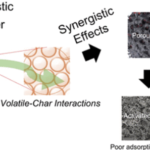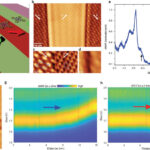2023-01-09 オーストラリア連邦研究会議(ARC)
ポリマーと呼ばれる分子の鎖は、紫外線やその他の光源にさらされると特定の色に発光するなど、さまざまな視覚効果を生み出すパターンで組み合わされることがある。
ポリマーは、データストレージ、セキュリティインク、有機発光ダイオード(OLED)、さらには太陽エネルギー産業にも利用されている。
これまで、目的の効果を生み出すために分子を正しい順序で並べるには試行錯誤が必要で、実用化や有用性に限界があった。
この問題を解決するため、RMIT大学のExciton Science研究員Nastaran Meftahi博士は、Salvy Russo教授の指導のもと、機械学習モデルをトレーニングし、分子内部や分子間で起こる挙動をよりよく理解することに成功しました。限られた量のデータしかなかったにもかかわらず、Nastaranが作成したモデルは高速に学習することが証明されました。
このモデルによって、ポリマーをより効率的かつ効果的に組み立てる方法に関する重要な新情報が得られ、さまざまな実験や商業的な目的に利用できるようになった。
<関連情報>
- https://excitonscience.com/news/machine-learning-unlocks-fluorescent-molecular-tools-information-encryption
- https://www.sciencedirect.com/science/article/abs/pii/S2451929422006465
機械学習を用いた電荷移動に依存したフルカラー発光を実現する汎用的な高分子プラットフォームの探索 Machine learning-assisted exploration of a versatile polymer platform with charge transfer-dependent full-color emission
Suiying Ye,Nastaran Meftahi,Igor Lyskov,Tian Tian,Richard Whitfield,Sudhir Kumar,Andrew J.Christofferson,David A.Winkler,Chih-Jen Shih,Salvy Russo,Jean-Christophe Leroux,Yinyin Bao
Chem Published: January 2, 2023
DOI:https://doi.org/10.1016/j.chempr.2022.12.003

Highlights
- •Machine learning directs the design of through-space charge transfer polymers
- •Full-color emission of solid polymers is tuned by simple polymerization
- •Donor-acceptor distance within ∼7 Å is crucial for charge transfer emission
- •Photoresponsive donor monomer allows high-contrast photochromic fluorescence
The bigger picture
Understanding the color tuning of solid-state emissive materials is essential from a fundamental mechanistic viewpoint, as well as for practical applications. Despite copious research into molecular design and engineering, a general and facile polymer platform that offers high flexibility and broad extensibility in emission color tuning is still lacking. Here, guided by a machine learning model, we developed a series of through-space charge transfer polymers with full-color-tunable emission. This is achieved by simple polymerization of aromatic monomers with varied electron-donating ability, using an electron-withdrawing fluorophore as the initiator. Theoretical calculations reveal that redshifted charge transfer emission can be generated at a donor-acceptor spatial proximity within ∼7 Å, which could be influenced by the donor group concentration in polymers. This work opens new perspectives for the design of color-tunable solid polymers and stimuli-responsive fluorescent materials.
Summary
The development of color-tunable fluorescent materials with simple chemical compositions that are easy to synthesize is highly desirable but practically challenging. Here, we report a versatile yet simple platform based on through-space charge transfer (TSCT) polymers that has full-color-tunable emission and was developed with the aid of predictive machine learning models. Using a single-acceptor fluorophore as the initiator for atom transfer radical polymerization, a series of electron donor groups containing simple polycyclic aromatic moieties (e.g., pyrene) are introduced either by one-step copolymerization or by end-group functionalization of a pre-synthesized polymer. By manipulating donor-acceptor interactions via controlled polymer synthesis, continuous blue-to-red emission color tuning was easily achieved in solid polymers. Theoretical investigations confirm the structurally dependent TSCT-induced emission redshifts. We also exemplify how these TSCT polymers can be used as a general design platform for solid-state stimuli-responsive materials with high-contrast photochromic emission by applying them to proof-of-concept information encryption.



